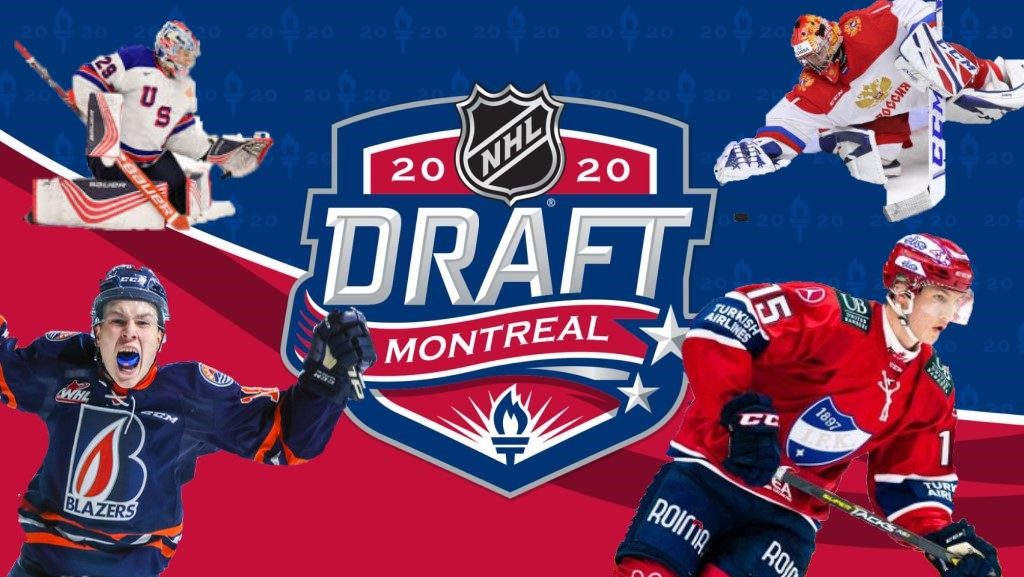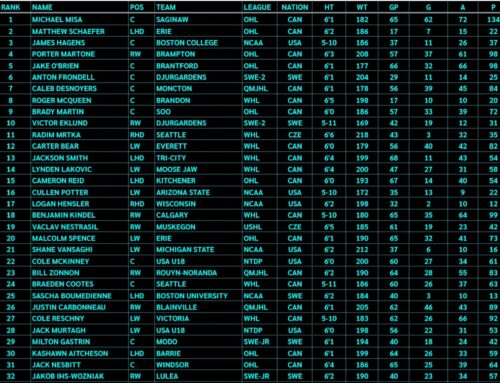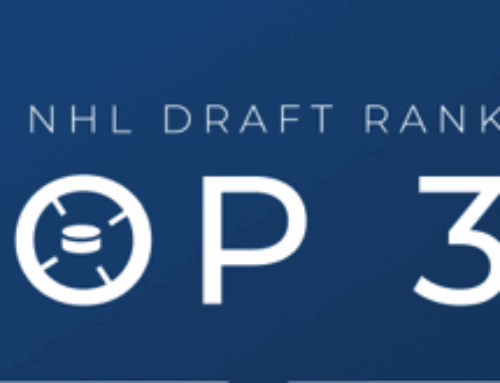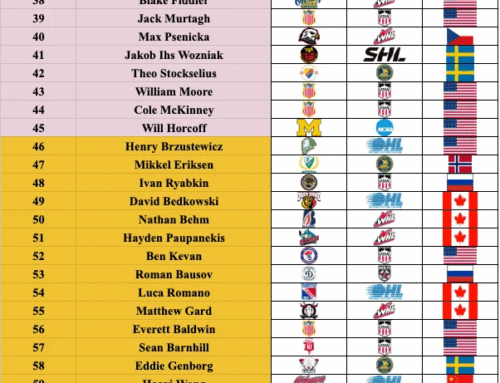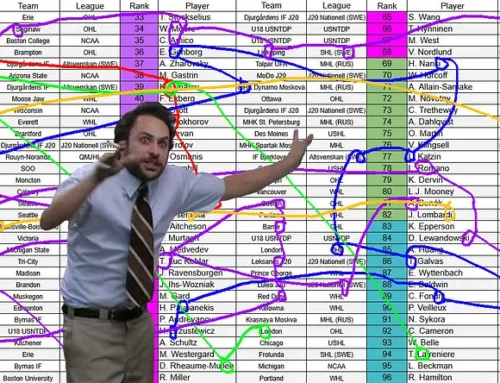April Draft Report: Mailbag, Defense and Mr. Safety
Tony Ferrari
2020-04-29
The NHL Draft Report is a monthly column that highlights a number of topics in the NHL Draft world at the time. Each month will have the main feature story, a themed ‘Team of the Month’, and a Prospect Spotlight that takes a bit of a deeper look at a player. This month the Draft Report includes a ‘Mailbag’ of questions from Twitter, the All-Defensive Team and a Prospect Spotlight on Kamloops Blazers center Connor Zary.
Mailbag Time!
I asked you for questions and I got what I asked for! I’ve chosen some of the best from the comments and a few DMs that I received and I’ll do my best to answer them! I am sorry I couldn’t get to all of them but if I didn’t get to them and you really want to hear my opinion, feel free to DM me @theTonyFerrari and I will get back to you there! Without further ado, let’s get to some of your questions!
https://twitter.com/keithfries/status/1254850388047458304?s=20
I’m not against Yaroslav Askarov in the top-three in theory but I can’t do it myself because of the volatility of the goaltender position. While I haven’t been on the “Goalies are Voodoo” train for a while, there is some truth to it. I think that because of the position’s dependence on the team in front of him, to a degree, it makes this a bit more difficult for me.
While I believe there is a chance, as small as it may be, that Askarov is the best player in the draft class when we look back on it in a decade, there is a real chance, equally as small, that he amounts to nothing. Add to that, many teams still struggle with scouting netminders because they don’t always have specialized scouts. As much as I appreciate the boldness of putting Askarov third, the highest I could argue myself to is sixth. I love Askarov and I truly believe he is one of the best goalie prospects to come out in a long, long time but there is still volatility to the position I can’t justify passing on a Tim Stützle or a Lucas Raymond because of it.
Interested in what your take is on powerplay production when evaluating someone’s overall production. Do you hold it against a player for having large chunks of powerplay production, or credit their prowess on the man advantage?
Looking forward to the article, Tony! 🍻
— Brandon Holmes (@BHolmes_Hockey) April 27, 2020
This is an interesting question. The short answer is that I think powerplay production is different based on different player’s circumstances. I think that in junior hockey, powerplay production is very easy to come by. The disorganization and inexperience on the penalty kill often lead to skilled players dominating in the extra space. It is a regular occurrence for junior teams are just putting out their veterans and overage players on the penalty kill and this oftentimes leads to the skilled players taking advantage and destroying worlds on the powerplay.
This is a valuable skill and something that I think makes a prospect special. My opinion has always been that I don’t mind powerplay production but I will always value even-strength production more because the game of hockey is played at five-on-five the vast majority of the time. I look for a powerplay specialist to be at least competent at even-strength and if there become concerns there, the player’s powerplay production becomes less impressive. I think that there are players like Tyson Foerster who scored 18 of his 36 goals on the powerplay (50%) and I do raise an eyebrow. I think the traits that make him a dangerous scorer can be used on the powerplay at the next level as well and he could be a 30 goal scorer at the NHL level, the issue is that the majority of his scoring will come when his team has the man advantage making the majority of his ice-time less effective. (Note: the clip below of Foerster scoring a goal was just to show that I realize just how good this kid’s shot is and it’s fun to watch)
There are cases where I can forgive a large portion of the player’s production coming from the powerplay and that is when the player is playing in a professional men’s league. This is a bit of a different scenario in that the young players often don’t get premier minutes and when they do, its against men. This is where the eye test and analytics tracking can aid in your scouting as you can evaluate the player beyond his raw statistics. This should be done with all players, men’s league or not, but the players in men’s leagues it becomes all the more important, especially if they are producing on the PP but not at five-on-five.
All in all, this was a long-winded way to say yes, powerplay production does heavily factor into a player’s analysis on my end but I try to contextualize each player’s situation from deployment to powerplay opportunity. Sometimes a player is on the opposite end of the spectrum and their production is limited by a severe lack of powerplay time as well so it does go both ways.
A legit question this time! What did you think of Ville Ottavainen's rookie season in the OHL?
— Jokke Nevalainen (@JokkeNevalainen) April 27, 2020
Honestly, it was pretty underwhelming overall. I liked his start to the year in Kitchener, he seemed to have some jump in his step and he was effective and moving the puck around the ice and playing well in his own end. There were warts but they seemed to have a lot to do with strength rather than a lack of skill or mobility. He was making good decisions and the play was seemingly being pushed towards the offensive zone when he was on the ice.
This changed just before the new year. Ottavainen was becoming more reserved and possibly didn’t gel with the new coaching staff after the teams coach to start the season, Jay Mckee, was fired at the end of November. General Manager Mike McKenzie took over and after he seemed to get the team turned around, Ottavainen trended in the opposite direction. He seemed to go from a good player on a disorganized and underperforming team to an underwhelming player on a good team when the Rangers turned it around. The overall grade is a solid ‘C’.
Who had a big second half of the season that you think is most legit, and is a sign of a positive step in their development vs a hit streak?
— AleSTANdro Kirk (@brigstew86) April 27, 2020
Simply put, I think the one player that had a strong second half that I think is a product of positive development rather than a hot streak is Jake Sanderson. This may come as a surprise from me. I have been well on record as saying that this draft has one defender worthy of a top-15 pick in this year’s draft, likely meaning that Sanderson and any other defender would be outside of the top-15. This in the face of many analysts having Sanderson shoot up the board and into the top-eight.
So how do I justify saying that the hype is real while also being the “pump the breaks” guy? I honestly believe that the rise of Sanderson and his strong second half was legitimate. I think that even at the beginning of the year, there was instances of offensive upside with Sanderson and his ability to defend is so far ahead of the majority of the defensemen in this draft. The second half pushed Sanderson into the first round and into consideration for the top-15 in terms of best player available. His offensive game came alive after the New Year and he showed that he could be a capable secondary option on the powerplay while being a minute-eating defensive presence at even-strength. That alone is worth a top-10 pick in the majority of drafts but the 2020 draft is very strong up top and that pushes players back.
A good nugget from one NHL agent on the top of the #2020NHLDraft recently:
"This draft is so top heavy. In another draft, these guys would be top five picks all day long. But the top 10 in this draft is like the top five in another."
— Scott Wheeler (@scottcwheeler) April 28, 2020
Teams don’t draft for the best player available like we all like to think they do. NHL teams draft for position far more often than we would like to admit. They like to fill needs within their system and if every team needs more defenders in their system and the maturity of Sanderson’s game and the attractiveness of defense to the old-school scouts often win out in these situations. Teams always reach for defenders and this year will be no different. So, if you’re going to reach then Sanderson is a good option with a lot of upside and he is one of the younger players in this draft class which could mean even further development at a pivotal age for a player.
“Which prospect will see his stock fall, and why?”
This is tough. It’s often a player that the public loves but is a bit undersized or the overseas player who doesn’t get the exposure because he plays in Europe. The player I’ll pick for this one fits both of those criteria. Alexander Pashin has the skill of a top-15 player in the 2020 draft, a noted strong draft (see above again). The issue is that he is fairly inconsistent, only 5’7″ and 154lbs and he plays in the MHL. The Russian junior league is fairly wild and the competition from game to game can vary because of the vast discrepancies between the talent levels of the top teams and the bottom teams.
Alexander Pahsin (#34 in the video below) is an exciting winger who plays an uptempo game and drives play in a positive direction. When he is at his best, his diminutive size is no issue and the winger dominates the medium danger areas of the ice. He attacks the slot but doesn’t always get in tight on the net. He plays with tenacity and has a willingness to work on the cycle and excels unlike many players his size. His shot is very good and he could be a decent goal scorer at the NHL level but his bread and butter is his silky smooth playmaking. Pashin makes passes that most players don’t think about. His creativity is wild at times and his two-way play is underrated in a league that has very little defensive structure. Overall, Pashin is a first-round talent despite the inconsistencies.
As stated, he is small and plays overseas. He has some inconsistencies on top of that and that mix could wind up making a team very happy in the second round. Pashin has the tools to become an effective middle-six winger who could be effective in all three zones and tear opposing teams apart on the powerplay. His upside is very high but his floor is low as well. The talent is undeniable but smaller players do have to continuously prove that they can play at the next level and he may take a couple of seasons to work his way through the ranks and eventually to the NHL.
“Is Marco Rossi a Top 5 pick, and why?”
Yes. The reason? He’s really good.
“Who is the second-best defender in the draft?”
This is a debate on amongst analysts and there really are a few answers I think can be justified. The aforementioned Jake Sanderson is a defensive stalwart who still flashes upside and showed tremendous growth through the season. There is a valid argument for the Swedish trio of Emil Andrae, William Wallinder, and Helge Grans who all bring slightly different packages. Andrae is small (5’9″, 183lbs) but skilled, intelligent, and the most well rounded of the trio. He excels at both ends of the ice and produces consistently. Wallinder is a physical freak who has some decision making questions but the raw tools are impressive. He has great size, skates well, and shows the skills needed to be a productive NHL top-four defender. Grans is a bit more proficient in the offensive zone but he has physical traits like Wallinder. His defensive zone play is wildly inconsistent and he also struggles at times with his decision making but he may have the highest upside of the trio.
Those four players are all in consideration for the second-best defender and if I had to choose one, I would lean towards Sanderson and then Andrae close behind. There are a few others who could have an argument made for them such as the run and gun, risk-taker Jérémie Poirier whos defensive downsides are egregious but his offensive play could be special. Lukas Cormier is a beast on the powerplay but his even-strength play leaves you wanting more. Kaiden Guhle gets a ton of love because he is a physical defender who defends the rush well and makes an excellent first pass. His offensive upside seems fairly limited but he is a very safe bet to be an NHL defender. There are a number of defenders who could be the second off the board but the reality is they will likely go higher than they should in a ‘best player available’ situation.
“Is the 2021 draft better than the 2020 draft?”
The short answer is no. The 2020 draft has an insane amount of talent at the top of it. Alexis Lafrenière and Quinton Byfield are both deserving of being first overall picks and they will likely both alter the franchises they step into. Players like Lucas Raymond, Rossi, and Stutzle would be in consideration for second overall in many draft years and it’s likely one will be available outside the top-five. Cole Perfetti or Alexander Holtz could very well fall out of the top-10 and they are bonafide top-five talents. There are some who believe that while most years have anywhere from 3-8 first-round talents available in round two, this year’s draft could very well have 15+.
The 2021 draft doesn’t have the franchise-altering talent at the top but it is a very good draft for defenders specifically. It also has the advantage of having some interesting goaltending prospects led by Jesper Wallstedt, a Swedish netminder who is in the same class as Spencer Knight in 2019 and Yaroslav Askarov this year. The draft may not be as flashy when it comes to top-end talent but it will be a draft that could go down as one that helps teams fill out their defensive corps with some very good blueliners at the top of the class such as Carson Lambos, Brandt Clarke, and Luke Hughes.
All-Defensive Team
F Rodion Amirov – F Anton Lundell – F Marco Rossi
LHD Jake Sanderson – RHD Topi Niemelä
G Drew Commesso
It only seems right to start from the net out on the ‘All-Defensive Team’ and while you probably expected to see the best netminder in the draft in Yaroslav Askarov but Drew Commesso doesn’t get the love that he deserves. Last year he was the NTDP’s U17 starting netminder last year and got a first-hand look at Spencer Knight and witnessed how the elite level goaltenders train and develop. On top of that, he has been competing against Askarov at the majority of the top international tournaments for the last couple of seasons.
Commesso has been in the shadow of his American predecessor and his Russian rival and while he isn’t on the same level as the two elite goaltending prospects, he isn’t far behind. He has better raw stats on a team of lesser quality than Spencer Knight did last season and he has played well at international competitions against Askarov in the past, even if Askarov has out-dueled him the majority of the time. Commesso is a calm, structured netminder who tracks the puck well and has the athleticism to make the desperation save. Commesso doesn’t get his justice as one of the best netminders in this draft class.
Keeping with the NTDP squad, Jake Sanderson is the clear cut the best defensive defenseman in the 2020 Draft. That’s not to say that his offensive game is a dead spot on his scouting report because his offensive numbers improved as the season wore on and he was able to show off his offensive IQ a bit more throughout the second half of the season. As for his defensive game, he utilizes his strengths and prevents zone entries better than just about any other player in the 2020 class. Sanderson uses his elite skating ability to keep a tight gap on the attacking player are meets them at the blueline. His good stick knocks the puck loose and oftentimes, he is the first to corral the puck and make a breakout pass. Sanderson’s ability to control the play when it comes to his end of the ice is impressive and his mobility allows him to be effective as they move the puck up ice as well.
His defensive partner on the team is a player who shares many of the same skills but doesn’t have the same kind of clout heading into the draft. Finnish defender Topi Niemelä has been playing above his age group for years now, playing fulltime in the Liiga this season on Kärpät, a perennially strong team who doesn’t always give their young players a legitimate opportunity. He skates well and uses his high-level intelligence to read the play at both ends of the ice. The thing that is most attractive about Niemelä is that he always finds a way to look good against his advanced competition. He seems to make the right read and has the ability to succeed when the play gets ratcheted up.
The All-Defensive Team’s forward core features three players who could be selected in the first 15 picks in the 2020 draft. Down the middle, Anton Lundell felt like the obvious answer as he is far and away the most high-end defensive specialist in the class. He is one of the smartest players in the draft and although he lacks the flash that some people want from their top-10 selection, Lundell’s defensive prowess and ability to play at a high level of efficiency at both ends of the ice drives him up draft boards. He supports his defenders low in the zone and clears the front of the net well when he’s asked to do it. He has pro size already and he doesn’t hesitate from being aggressive on the backcheck. Lundell is a defensive wizard when it comes to center prospects.
Marco Rossi could have filled the center role admirably but on this iteration of the team, Rossi gets pushed to the wing where he can take advatage of his powerhouse lower body and tenacious work ethic along the boards. He does an excellent job of battling in scrums and coming out with the puck. His size was never an issue this year as his core and leg strength is ‘Crosby-esque’ in the sense that he has the ability to carry players on his back at times while fending them off and protecting the puck. He eliminates passing lanes and reads and reacts to the opposition at an advanced level. Rossi often doesn’t get credit for his defensive game but he may have been the best defensive forward in the OHL this year, regardless of age and experience.
The only true winger on the team, Rodion Amirov isn’t the first name that comes to mind when we mention defense but the young Russian is a strong two-way winger who uses his knowledge of the offensive game to disrupt his opponent’s flow. He has an active stick and thrives on jumping passes. He can sometimes get manhandled physically but his defensive awareness is impressive. He uses his skill and speed to win puck battles, beating opponents to pucks rather than fighting through a scrum. His ability to pressure attackers through the neutral zone makes him a natural fit on this line.
Connor Zary: Mr. Safety
Possibly the safest pick in the first round, Kamloops Blazers center Connor Zary has been ranked in the mid-first round seemingly all season. He came into the year on the back of a 67-point performance in his draft minus-one season and as one of the oldest members of the draft class, he was expected to be even more impressive this season. He didn’t disappoint.
Zary has continued to put up big-time numbers with 86 points in 57 games this year. His 38 goals were good for second among WHL draft-eligibles and fifth in the entire WHL. He was the sixth-highest scoring draft-eligible player from any league. His offensive production has progressed in each of his three seasons and should be one of the best players in the WHL next season. He led the WHL in scoring at times through the first couple of months on the season. His defensive game has been improving every year as well, leading to a more complete overall game.
This maturity allows him to play in all situations and still maintain his offensive prowess. He lacks the flash and flair that could make him special but his play lends itself to efficiency, effectiveness, and the ability to win the possession game. Simplicity is the key to his game and although teams may shy away from that because his highlight reel isn’t as attractive, his game is very translatable. He is a high-floor/low-ceiling player who looks like a fairly safe bet to find a way to be a second-line center at the NHL level.
Zary has good speed and hands that can keep up. He takes shots when they present themselves and has the shot to make teams pay. His playmaking is steady and crisp. He won’t blow you away with too many no-look passes or find himself making a pinpoint pass through a crowd but he can make just about any pass that is a realistic option. Whether it be a cross-ice pass through the ‘Royal Road’ or a pass from the half-wall to the back post where a teammate can tap the puck in.
The lack of dynamism in his game may hold him back from being a real top scoring option at the NHL level but his reliability could get him into the NHL quickly. While he could slot in as a low-end number one center depending on the team, he shouldn’t slow in any lower than a solid third line scoring center that can mitigate the offense of the other team’s top unit. His defensive game may not be to the level of ‘shutdown center’ but he is capable and smart in his own end of the ice and he turns the puck up ice quickly.
Likely one of the top-two WHL forwards taken in the 2020 NHL Draft, Zary should be able to step into the NHL after one more season in the WHL. He has a lot of very good tools in the chest but he may not have anything that is outstanding. The young Canadian center has a high intelligence level and thinks the game like a pro. Whatever team Zary is selected by will be getting a safe player who has a projectable offensive game, a solid two-way game, and the ability to make players around him better.
*******
Thanks for joining me for the April NHL Draft Report. Be sure to check out my latest Ramblings about trying to find the ‘Elite Pests’ in this year’s draft class! If you have an idea for a feature story for next month, have a suggestion for the ‘Team of the Month’ or prospect spotlight, reach out! Let me know! I can always be reached on Twitter @TheTonyFerrari! Thank you again for reading this, whether you sat down with a pot of coffee and consumed it in one sitting or split it up over a few visits, I appreciate it all!
Make sure you check out the full Dobber Prospects 2020 NHL DRAFT PAGE! There are over 60 player profiles and a ton more draft content including the January Draft Report with a full breakdown of my Top-100 Rankings with video and analysis on 60+ players including nearly every player in the top-40!


